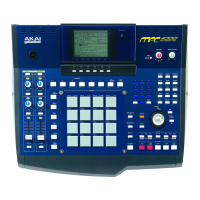Chapter 3—Creating and editing a sequence
26
5. Move the cursor to the Auto Step increment on key release field, and turn the [JOG] dial to make
the field show YES.
6. Move the cursor to the Duration of recorded notes field, and turn the [JOG] dial to make the
field show VALUE.
If you select TC VALUE, the note value you specified in the Timing correct field will be input here. The
numerical value at the right of the field indicates the proportion of the duration relative to the timing correct
value. If this value is 100%, the duration will be the same as the length of the note.
7. Press the [F1] key (CLOSE).
The settings will be finalized and the popup window will close.
8. Move the cursor to the Timing Correct field, and set timing correct to the shortest note value
that you will want to input (normally an 8th note or 16th note, etc.).
9. Move the cursor to the measure/beat/tick areas of the Now field, and specify the location at
which you want to begin step-recording.
10. Press the [REC] key or the [OVER DUB] key.
The [OVER DUB] key LED will light, and you are now ready to begin step-recording.
11. Strike the pads (or play your MIDI keyboard).
Note events will be recorded at intervals of the Timing Correct setting, and the current location will advance
by the length of the note value. The velocity value will be the strength with which you strike the pad or your
MIDI keyboard.
The recorded note events will appear in the event list as follows.
A Measure/beat/tick: Indicates the location at which the note event was recorded.
B Note number: Indicates the note number that was recorded, and the corresponding pad number (for a
DRUM type track) or note name (for an INST type track).
C D field: Indicates the duration of the note event in units of ticks.
D V field: Indicates the velocity of the note event.
If you changed the setting at the right of TC VALUE in step 6, that proportion will determine the duration
of the note events that you input. For example if Timing Correct is set to 16th note and Duration is 50%, the
result would be as follows.
12. To input a rest, press the STEP [
>
] key.
The current location will advance by the Timing Correct note value.
13. Continue step-recording in the same way.
If you have arrived at the end of the sequence and would like to continue step-recording from the beginning
of the sequence, move the cursor to the Now field, and use the [JOG] dial to change the current location.
14. When you are finished step-recording, press the [STOP] key.
You will exit step-recording.
Hint: If you set this field to AS PLAYED, the duration of the note event will depend on the length that you continue
pressing the pad or your MIDI keyboard. For details, refer to the PDF reference manual.
Hint: You can input a chord by simultaneously pressing two or more pads or notes on your MIDI keyboard.
Hint: You can return instantly to the beginning of the sequence by holding down the [GO TOP] key and pressing
the BAR [
<<
] key.
Hint: Step-recording can also be performed in the Sequence Edit page. When you step-record in the Sequence
Edit page, the note events you record will be shown in a graphic editor.
1
23 4
1
16th note
Note event
(50% of a 16th note)

